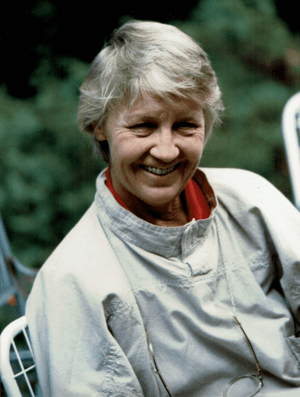Ruth Anderson (composer) facts for kids
Quick facts for kids
Ruth Anderson
|
|
|---|---|

Portrait of Ruth Anderson by Manny Albam
|
|
| Born | March 21, 1928 Kalispell, Montana, United States
|
| Died | November 29, 2019 (aged 91) |
| Occupation | Orchestrator, composer, teacher |
| Known for | Electronic music |
Ruth Anderson (born March 21, 1928 – died November 29, 2019) was an American composer, orchestrator, teacher, and flutist. She was known for her work in electronic music.
Contents
Who Was Ruth Anderson?
Ruth Anderson was born in Kalispell, Montana on March 21, 1928. She became a composer of both orchestral music and electronic music. She studied for many years at different schools, earning several awards and grants. These included two Fulbright awards. These awards allowed her to study music in Paris from 1958 to 1960. Her teachers there were famous composers Darius Milhaud and Nadia Boulanger.
After finishing her studies, Ruth Anderson worked as a freelance composer. She also arranged music for NBC-TV and later for Lincoln Center Theater.
Where Did Ruth Anderson Study?
Ruth Anderson had a long and impressive education. Here are some of the places she studied:
- 1949 — She earned a Bachelor of Arts degree from the University of Washington.
- 1951 — She earned a Master of Arts degree from the University of Washington.
- 1958–60 — She studied with Darius Milhaud and Nadia Boulanger at The American School at Fontainebleau.
- 1962–63 — She attended Princeton University Graduate School. She was one of the first four women ever admitted there!
- 1965, 1966, 1969 — She studied at the Columbia–Princeton Electronic Music Center. Today, this is called the Computer Music Center.
Ruth Anderson was a respected electronic composer. Her music has been released on several record labels. These include Opus One, New World/CRI, and Experimental Intermedia (XI). Her work was also featured on a very important album called New Music for Electronic and Recorded Media (1977) by Charles Amirkhanian.
What Kind of Music Did Ruth Anderson Make?
Ruth Anderson wrote music for many different instruments and groups. She composed for orchestras and created electronic music.
Her piece I Come Out of Your Sleep (1979, revised 1997) is a sound poem. It uses whispered sounds taken from a poem by Louise Bogan. Ruth Anderson said this piece should be listened to very quietly, "near the threshold of hearing." This means it should be heard almost like a whisper itself.
Another well-known piece is SUM (State of the Union Message) (1973). This piece is a sonic collage. It uses sounds from TV advertisements to sound like a speech by President Richard Nixon. Her piece DUMP (1970) is also a sonic collage.
Ruth Anderson started studying Zen in 1990. She felt this was a natural part of her music. She also said that composers Pauline Oliveros and Annea Lockwood influenced her, especially in her interest in music and healing.
Ruth Anderson's Teaching Career
After her studies, Ruth Anderson learned about tape manipulation. This made her realize that "all sounds" could be used to make music. In 1966, she joined the staff at Hunter College (CUNY). There, she created the Electronic Music Studio. She retired from teaching in 1988.
Just before she passed away in November 2019, Ruth Anderson approved the final test records for a new album of her work. This album, called Here, was released in February 2020. It includes:
- ‘I Come Out Of Your Sleep’
- ‘SUM’
- 'Pregnant Dream' (a collaboration with poet May Swenson)
- ‘Points’ (made only from pure sound waves called sine-waves)
- The electro-acoustic piece 'So What'
Ruth Anderson created dozens of musical pieces. Here are some of her selected works:
| Title | When it was Made | What it was For |
|---|---|---|
| Impression IV | 1950 | Soprano singer, flute, and string quartet |
| Sonata | 1951 | Flute and piano |
| Sonatina | 1951 | Flute and piano |
| Motet, Psalm XIII | 1952 | Mixed choir |
| Prelude and Allegro | 1952 | Woodwind quintet |
| Symphony for Small Orchestra | 1952 | Orchestra |
| Three Children's Songs | 1952 | Soprano singer and piano |
| Prelude and Rondo (dance score) | 1956 | Flute and strings |
| Song to My Father | 1959 | Women's voices and piano |
| Richard Cory | 1960 | Women's voices and piano |
| Wheel on the Chimney | 1965 | Music for a slide film and orchestra |
| The Pregnant Dream | 1968 | Tape recording |
| DUMP | 1970 | Tape recording |
| So What | 1971 | Tape recording |
| SUM (State of the Union Message) | 1973 | Tape recording |
| Conversations | 1974 | Tape recording |
| Points | 1974 | Tape recording |
| Sappho | 1975 | Tape recording |
| Tunable Hopscotch | 1975 | An art installation or game |
| I Come Out of Your Sleep | 1979, revised 1997 | Tape recording |
| Centering | 1979 | Interactive biofeedback: four "observers" with special sensors, and a dancer |
| Time and Tempo | 1984 | Biofeedback installation |
Images for kids


